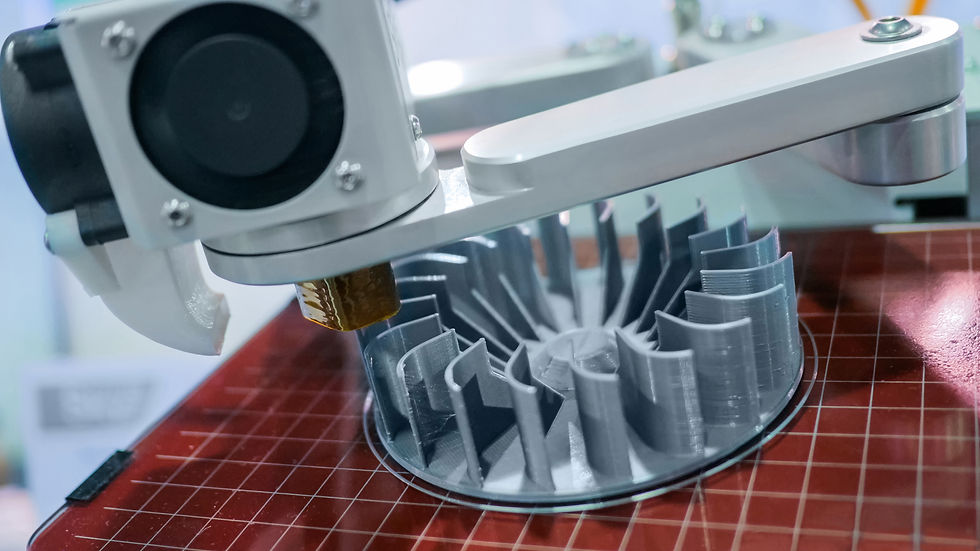3D Printing Spare Parts: A Case Study on Efficiency and Cost Savings
- Nathan Griese
- Mar 31
- 4 min read

Introduction: Transforming Spare Parts Manufacturing with 3D Printing
The demand for spare parts in various industries has always been a challenge due to long lead times, high storage costs, and logistical inefficiencies. Traditional manufacturing methods often require expensive tooling and batch production, leading to excessive waste and delays. With advancements in additive manufacturing, 3D printing spare parts has emerged as a viable solution for industries ranging from automotive and rail to maritime and aerospace.
The ability to produce on-demand parts without requiring a massive inventory is transforming supply chains worldwide. Companies like Hyundai Merchant Marine, Daimler Buses, and Hitachi Rail have begun leveraging 3D printing to streamline spare part production. This case study explores the impact of 3D printing on spare parts manufacturing, highlighting cost reductions, improved efficiency, and industry-wide adoption.
The Need for 3D Printing in Spare Parts Production
Challenges in Traditional Spare Parts Manufacturing
Industries that rely heavily on spare parts, such as transportation, heavy machinery, and manufacturing, often face significant hurdles in maintaining an adequate parts inventory. The main challenges include:
Long lead times: Many spare parts must be sourced from overseas suppliers, leading to long delivery times.
High storage costs: Warehousing spare parts for years increases expenses, especially for rarely used components.
Obsolescence: Manufacturers often discontinue parts, leaving companies with no choice but to re-engineer solutions at high costs.
Customization limitations: Standardized parts may not always fit unique or legacy equipment, requiring modifications that add time and cost.
How 3D Printing Solves These Challenges

3D printing enables on-demand production, reducing the need for warehousing large inventories. By using digital files instead of physical stock, manufacturers can create components only when needed. This approach eliminates obsolescence, lowers costs, and allows for rapid part customization. Companies like Daimler Buses and Hitachi Rail have already demonstrated the effectiveness of this approach, printing complex parts that were previously difficult to source.
Case Studies: Industry Adoption of 3D Printed Spare Parts
Hyundai Merchant Marine: Onboard 3D Printing for Maritime Efficiency
Hyundai Merchant Marine (HMM) is pioneering the use of 3D printing to produce spare parts onboard its cargo ships. Traditionally, maritime companies rely on land-based manufacturing facilities to produce and ship parts globally, which leads to extended downtime and high costs.
By implementing onboard 3D printing, HMM has reduced waiting times for critical repairs, ensuring operational efficiency. Early trials indicate that producing components directly on vessels can cut costs by up to 50% and reduce repair times from weeks to hours. This method not only improves ship reliability but also reduces the environmental impact of shipping spare parts worldwide.
Daimler Buses: Digital Inventory for Faster Maintenance
Daimler Buses, under its Omniplus service, has adopted a digital inventory system where spare parts are stored as 3D files instead of physical stock. With this approach, bus operators can request parts, which are then printed on-demand at certified production centers.
This initiative has led to a 60% reduction in lead times and a significant decrease in storage costs. The ability to print parts locally also minimizes the risk of supply chain disruptions, ensuring that buses remain operational with minimal downtime. Daimler’s approach demonstrates how 3D printing can revolutionize fleet management by providing rapid access to essential spare parts.
Hitachi Rail: Customizing Rail Components with 3D Printing
Hitachi Rail has partnered with Roboze to 3D print spare parts for its rail systems. This collaboration enables Hitachi to manufacture lightweight, high-strength components with enhanced durability.
By shifting to 3D printing, Hitachi Rail has reduced manufacturing time by 75%, allowing for faster maintenance and repairs. Additionally, printed parts can be customized to fit specific trains, ensuring compatibility and performance optimization. This case highlights how 3D printing is making public transportation more efficient and cost-effective.

The Economic and Environmental Benefits of 3D Printed Spare Parts
Cost Reduction and Efficiency Gains
Industries implementing 3D printing for spare parts have reported significant cost savings. The main areas of cost reduction include:
Lower material waste: Additive manufacturing uses only the necessary material, reducing scrap.
Elimination of expensive tooling: Traditional methods require molds and fixtures, which are costly to produce and maintain.
Faster repair turnaround: On-demand printing eliminates waiting periods for suppliers to ship parts.
Reduced transportation costs: Printing locally removes the need for expensive international shipping and customs delays.
Environmental Impact
3D printing also contributes to sustainability efforts by minimizing material waste, reducing carbon emissions associated with shipping, and enabling longer equipment lifespans through rapid part replacement. By manufacturing parts as needed, industries can lower their carbon footprint and support eco-friendly production practices.
Future Outlook: How 3D Printing is Shaping Spare Parts Manufacturing
As 3D printing technology advances, its application in spare parts manufacturing is expected to expand across multiple industries. The key trends shaping the future include:
Increased material options: Advancements in metal and composite 3D printing will enable more durable and high-performance spare parts.
Greater adoption in aerospace and defense: These industries require specialized components that benefit from 3D printing’s ability to create complex geometries.
Integration with AI and automation: Smart manufacturing systems will optimize part design and production, further improving efficiency.
Companies that invest in 3D printing for spare parts will gain a competitive edge by reducing costs, improving supply chain resilience, and enhancing product customization.

Conclusion: The Growing Role of 3D Printing in Spare Parts
The use of 3D printing for spare parts is revolutionizing industries by offering faster, cost-effective, and sustainable solutions. Companies like Hyundai Merchant Marine, Daimler Buses, and Hitachi Rail are leading the way in adopting this technology to improve efficiency and reduce operational costs. As additive manufacturing continues to evolve, more businesses will embrace digital inventories and on-demand production, ensuring that critical spare parts are available when and where they are needed.




Comments